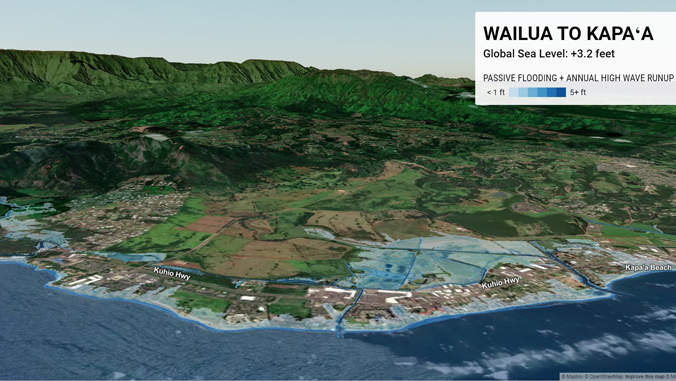
In the quest to prepare for and mitigate the effects of climate change, Kauaʻi Mayor Derek Kawakami signed a historic bill on October 14, Bill No. 2879, that will regulate construction based on future sea-level rise projections. This unique measure is the result of dedicated collaboration between the University of Hawaiʻi at Mānoa’s Climate Resilience Collaborative and the Kauaʻi County Planning Department.
This bill makes Kauaʻi one of the first counties in the nation to commit to using scientific model projections as the basis for construction and planning regulations—thus prioritizing the safety and resilience of communities, infrastructure and ecosystems.
For many years, the UH Mānoa Climate Resilience Collaborative (formerly the Coastal Geology Group) has developed innovative computer model projections of areas across the Hawaiian Islands where chronic coastal flooding and erosion are expected to occur as sea level rises in the coming decades. These published and peer-reviewed predictions are the basis for the County of Kauaʻi Sea Level Rise Constraint District Viewer that will now be used to ensure resilient planning and design.
“The Climate Resilience Collaborative has worked closely with the Kauaʻi County Planning Department to fine-tune the data to ensure the highest quality and create a stand-alone viewer that can be used as a planning tool,” said Chip Fletcher, interim dean of the UH Mānoa School of Ocean and Earth Science and Technology and director of the collaborative.
Historically, land use decisions have been made by legislatures based on various zoning and planning policies combined with recognized environmental hazards, such as one hundred-year floods.
“By using modeling, as opposed to historical data, we’re in a better position to ensure that efforts to build or rebuild infrastructure and homes are being made with the future in mind,” said Kaʻaina Hull, director of planning for Kauaʻi County. “This bill is a culmination of years of hard work and we are proud to be one of the first counties to lead in implementing progressive building policies related to sea-level rise.”
“The latest IPCC [Intergovernmental Panel on Climate Change] reports tell us with high confidence that sea-level rise will persist for ‘centuries to millennia’ due to ongoing warming of the oceans and melting of the ice sheets,” said Fletcher. “There is nothing we can do to stop sea-level rise, and in the interest of public health and safety, we need to adapt to its impacts. This measure will minimize the flood threat, promote resilient planning and design, and minimize the expenditure of public money for costly flood control projects necessitated by accelerating sea-level rise. Kauaʻi is providing an example for coastal communities around the nation of the next right step in building community resilience to climate change impacts.”
In addition to the Climate Resilience Collaborative and the Kauaʻi Planning Department, partners include: Hawaiʻi Sea Grant, Department of Land and Natural Resources, the Pacific Islands Ocean Observing System, SSFM International and Sea Engineering, Inc.
–By Marcie Grabowski

